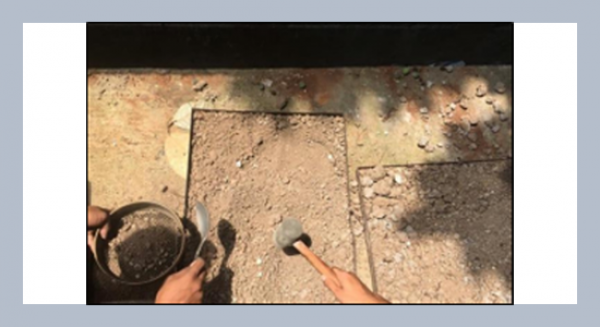REFERENCES
- Abou-Chakra, H., Tüzün, U. 1999. Coefficient of friction of binary granular mixtures in contact with a smooth wall:Part I: Direct shear box measurements of the effects of particle size ratio and particle surface roughness. Chemical Engineering Ecience. 5901–5912.
- Arancon, N.Q., Edwards, C.A., Bierman, P., Metzger, J.D., Lee, S. Welch, C., 2003. Effects of vermicomposts on growth and marketable fruits of field-grown tomatoes, peppers and strawberries: The 7th International Symposium on Earthworm Ecology, Cardiff Wales, United Kingdom. 731–735.
- Arora, V.K., Singh, C.B., Sidhu, A.S., Thind, S.S. 2011. Irrigation, tillage and mulching effects on soybean yield and water productivity in relation to soil texture. Agricultural Water Management. 98. 563–568.
- Arthur, A., Dogbatse, J.A., Quaye, A.K., Konlan, S. 2019. Effect of municipal solid waste compost on soil chemical properties and growth performance of cocoa (theobroma cacao l.) seedlings at the nursery in Ghana. International Journal of Plant and Soil Science, 28, 1–8.
- Baghdadi, A., Halim, R.A., Ghasemzadeh, A., Ramlan, M.F., Sakimin, S.Z. 2018. Impact of organic and inorganic fertilizers on yield and quality of silage corn in intercropped system with soybean (No. e26905v1). PeerJ Preprints.
- Bhat, N.A., Riar, A., Ramesh, A., Iqbal, S., Sharma, M.P., Sharma, S.K. Bhullar, G.S., 2017. Soil biological activity contributing to phosphorus availability in vertisols under long-term organic and conventional agricultural management. Frontiers in Plant Science. 8. 1523.
- Blake, G.R., Hartage, K.H. 1986. Method of soil analysis part 1. American Society of Agronomy, Inc. Wisconsin, USA.
- Bray, R.H., Kurtz, L.T., 1945. Determination of total, organic, and available forms of phosphorus in soils. Soil science. 59. 39–46.
- Chaulagain, A., Gauchan, D.P., Lamichhane, J. 2017. Vermicompost and its role in plant growth promotion. International Journal of Research. 4. 850–864.
- Department of Statistics Malaysia. 2018. Agriculture. agriculture. putrajaya, malaysia: department of statistics. Retrieved from: https://www.dosm.gov.my/v1/index.php?r=column/ctwoByCat&parent_id=45&menu_id=Z0VTZGU1UHBUT1VJMFlpaXRRR0xpdz09
- Doan, T.T., Henry-Des-Tureaux, T., Rumpel, C., Janeau, J.L., Jouquet, P. 2015. Impact of compost, vermicompost and biochar on soil fertility, maize yield and soil erosion in Northern Vietnam: A three-year mesocosm experiment. Science of the Total Environment. 514. 147–154.
- Duchicela, J., Vogelsang, K.M., Schultz, P.A., Kaonongbua, W., Middleton, E.L., Bever, J.D. 2012. Non‐native plants and soil microbes: potential contributors to the consistent reduction in soil aggregate stability caused by the disturbance of North American grasslands. New Phytologist. 196. 212–222.
- Dungait, J.A., Hopkins, D.W., Gregory, A.S., Whitmore, A.P. 2012. Soil organic matter turnover is governed by accessibility not recalcitrance. Global Change Biology. 18. 1781–1796.
- Edmeades, D.C. 2003. The long-term effects of manures and fertilisers on soil productivity and quality: a review. Nutrient cycling in Agroecosystems. 66. 165–180.
- Gaiser, T., Stahr, K. 2013. Ecosystem services and carbon sequestration in the biosphere. Springer. Dordrecht, Netherland.
- Gan, J.K.M., Fredlund, D.G., Rahardjo H. 1988. Determination of the shear strength parameters of an unsaturated soil using the direct shear test. Canadian Geotechnical Journal. 25. 500–510.
- Ganeshnauth, V., Jaikishun, S., Ansari, A.A., Homenauth, O. 2018. Automation in agriculture-securing food supplies for future generations. Intech. Rijeka, Croatia.
- Gee, G.W., J.W. Bauder. 1986. Methods of soil analysis part 1. Soil Science Society of America Book Series 5. Madison, Wisconsin, USA.
- Ghestem, M., Veylon, G., Bernard, A., Vanel, Q., Stokes, A. 2014. Influence of plant root system morphology and architectural traits on soil shear resistance. Plant and Soil. 377. 43–61.
- Guerrero III, R. D. 2010. Vermicompost production and its use for crop production in the Philippines. International Journal of Global Environmental Issues. 10. 378–383.
- Guo, R., Sun, S., Liu, B. 2016. Difference in leaf water use efficiency/photosynthetic nitrogen use efficiency of Bt-cotton and its conventional peer. Scientific Reports. 6. 33539.
- Haitao, Z., Tianpeng, L., Yuhua, S., Ke, F., Zhijun, Y., Qiande, Z. 2017a. Effects of adding mineral nutrients to vermicompost on the growth of eggplant (Solanum melongena) in the greenhouse. Journal of Residuals Science and Technology. 14. 41–49.
- Halim, A., Sa’adah, N., Abdullah, R., Karsani, S.A., Osman, N., Panhwar, Q.A., Ishak, C. F. 2018. Influence of soil amendments on the growth and yield of rice in acidic soil. Agronomy. 8. 165.
- Han, S.H., An, J.Y., Hwang, J., Kim, S.B., Park, B.B. 2016. The effects of organic manure and chemical fertilizer on the growth and nutrient concentrations of yellow poplar (Liriodendron tulipifera Lin.) in a nursery system. Forest science and Technology. 12. 137–143.
- Hazelton, P., Murphy, B. 2016. Interpreting soil test results: What do all the numbers mean? CSIRO publishing. Clayton, Australia.
- Hazra, G. 2016. Different types of eco-friendly fertilizers: An overview. Sustainability in Environment, 1, 54.
- Hetrick, S., Ketterings, Q., Czymmek, K., Sadeghpour, A., Langner, A., O’Neill, K., Gabrie. A. 2016. Improving aggregate stability. Field Crop Extension. Cornell University Cooperative Extension.
- Hlisnikovsky, L., Kunzová, E., Hejcman, M., Škarpa, P., Zukalová, H., Menšík, L. 2015. The effect of climate, nitrogen and micronutrients application on oiliness and fatty acid composition of sunflower achenes. Helia. 38. 221–239.
- Hussain, N., Abbasi, S.A. 2018. Efficacy of the vermicomposts of different organic wastes as “clean” fertilizers: state-of-the-art. Sustainability, 10, 1205.
- Imran. 2018. Organic matter amendments improve soil health, productivity and profitability of maize and soybean. Annual Review and Research. 1. 66–69.
- Kemper, W.D., Rosenau, R.C. 1986. Method of soil analysis part 1. American Society of Agronomy, Inc. Wisconsin, USA.
- Khairuddin, M.N., Isa, I.M., Zakaria, A.J., Jol, H., Syahlan, S. 2017. Shear strength and root length density analyses of Entisols treated with palm oil mill effluent sludge. Soil and Environment Journal. 36. 131–140.
- Khairuddin, M.N., Md Isa, I., Zakaria, A.J., Syahlan, S. 2017. Ameliorating Plant available water by addition of Treated Palm Oil Mill Effluent (POME) Sludge on Entisols. Journal of Agricultural Science. 9. 218.
- Khairuddin, M.N., Zakaria, A.J., Isa, I.M., Jol, H., Rahman, W.M.N. W.A., Salleh, M.K.S. 2016. The potential of treated palm oil mill effluent (POME) sludge as an organic fertilizer. AGRIVITA, Journal of Agricultural Science. 38. 142–154.
- Kirkby MJ. 1980. Soil erosion: soil loss estimation. Wiley Publishing. New York.
- Kumar, R., Kumar, R., Prakash, O. 2019. Chapter-5 the impact of chemical fertilizers on our environment and ecosystem. Chief Editor, 35, 69.
- Kusumi, K., Hirotsuka, S., Kumamaru, T., Iba, K. 2012. Increased leaf photosynthesis caused by elevated stomatal conductance in a rice mutant deficient in SLAC1, a guard cell anion channel protein. Journal of Experimental Botany. 63. 5635–5644
- Li, Y., He, N., Hou, J., Xu, L., Liu, C., Zhang, J., Wang, Q., Zhang, X., Wu, X. 2018. Factors influencing leaf chlorophyll content in natural forests at the biome scale. Frontiers in Ecology and Evolution. 6. 64.
- Libohova, Z., Seybold, C., Wysocki, D., Wills, S., Schoeneberger, P., Williams, C., Lindbo, D., Stott, D. Owens, P.R., 2018. Reevaluating the effects of soil organic matter and other properties on available water-holding capacity using the National Cooperative Soil Survey Characterization Database. Journal of Soil and Water Conservation. 73. 411–421.
- Lin, W., Lin, M., Zhou, H., Wu, H., Li, Z., Lin, W. 2019. The effects of chemical and organic fertilizer usage on rhizosphere soil in tea orchards. PLoS ONE 14. e0217018.
- Mahmud, M., Abdullah, R., Yaacob, J.S. 2018. Effect of vermicompost amendment on nutritional status of sandy loam soil, growth performance, and yield of pineapple (Ananas comosus var. MD2) under field conditions. Agronomy. 8. 183.
- McCauley, A., C. Jones, J. Jacobsen. 2009. Nutrient management’s module. Montana State University. Bozeman, USA.
- McLean, E.O., Bhumbla, D.R. 1965. Aluminum in soils: VI. Changes in pH‐dependent acidity, cation‐exchange capacity, and extractable aluminum with additions of lime to acid surface soils. Soil Science Society of America Journal. 29. 370-374.
- Metson, A.J., 1957. Methods of chemical analysis for soil survey samples. Soil Science. 83. 245.
- Mirza, H., Ahamed, K.U., Rahmatullah, N.M.N., Akhter, K.N., Rahman, M. L. 2010. Plant growth characters and productivity of wetland rice (Oryza sativa L.) as affected by application of different manures. Emirates Journal of Food and Agriculture. 22. 46–58.
- Najafpour, G.D., Zinatizadeh, A.A.L., Mohamed, A.R., Isa, M.H., Nasrollahzadeh, H. 2006. High-rate anaerobic digestion of palm oil mill effluent in an upflow anaerobic sludge-fixed film bioreactor. Process Biochemistry. 41. 370–379.
- Nizar, M.K., Isharudin, M.I., Abd Jamil, Z., Hazandy, A.H. 2018. Influence of treated palm oil mill effluent sludge on maize (Zea mays) growth performance and gas exchange. Sains Malaysiana. 47. 961–969.
- O'Neal, A.M. 1949. Soil characteristics significant in evaluating permeability. Soil Science. 67. 403-410.
- Persson, J.Å. 2008. Handbook for kjeldahl digestion. FOSS. Hilleroed, Denmark.
- Richards, L.A. 1941. A pressure-membrane extraction apparatus for soil solution. Soil Science. 51. 377–386.
- Roy, S., Arunachalam, K., Dutta, B.K., Arunachalam, A. 2010. Effect of organic amendments of soil on growth and productivity of three common crops viz. Zea mays, Phaseolus vulgaris and Abelmoschus esculentus. Applied Soil Ecology. 45. 78–84.
- USDA. 1996. Key to soil taxonomy. NRCS. Washington, DC.
- USDA. 2008. Soil quality indicators: bulk density. USDA Natural Resources Conservation Service, USA.
- Varghese, S.M., Prabha, M.L. 2014. Biochemical characterization of vermiwash and its effect on growth of Capsicum frutescens. Malaya Journal of Biosciences. 1. 86–91.
- Vo, H.M., Wang, C. Ho. 2014. Vermicompost as an Important Component in Substrate: Effects on Seedling Quality and Growth of Muskmelon (Cucumis Melo L.). APCBEE Procedia. 8. 32–40.
- Walkley, A., Black, I.A. 1934. An examination of the Degtjareff method for determining soil organic matter, and a proposed modification of the chromic acid titration method. Soil science. 37. 29–38.
- Wang, J., Zhang, Y., Gong, S., Xu, D., Sui, J. 2017. Nitrogen fertigation effect on photosynthesis, grain yield and water use efficiency of winter wheat. Agricultural Water Management. 179. 277–287.
- Wang, L., Wang, S., Chen, W., Li, H., Deng, X. 2017. Physiological mechanisms contributing to increased water-use efficiency in winter wheat under organic fertilization. PLoS ONE. 12. 1–21.
- Wani, K.A., Rao, R.J. 2013. Bioconversion of garden waste, kitchen waste and cow dung into value-added products using earthworm Eisenia fetida. Saudi Journal of Biological Sciences. 20. 149-154.
- Yang, C.H., Chai, Q., Huang, G.B. 2010. Root distribution and yield responses of wheat/maize intercropping to alternate irrigation in the arid areas of northwest China. Plant, Soil and Environment. 56. 253–262.
- Zannah, T.I., Jusop, S., Ishaq, F.C., Roslan, I. 2016. FTIR and XRD analyses of highly weathered ultisols and oxisols in peninsular Malaysia. Asian Journal of Agriculture and Food Sciences, 4.















